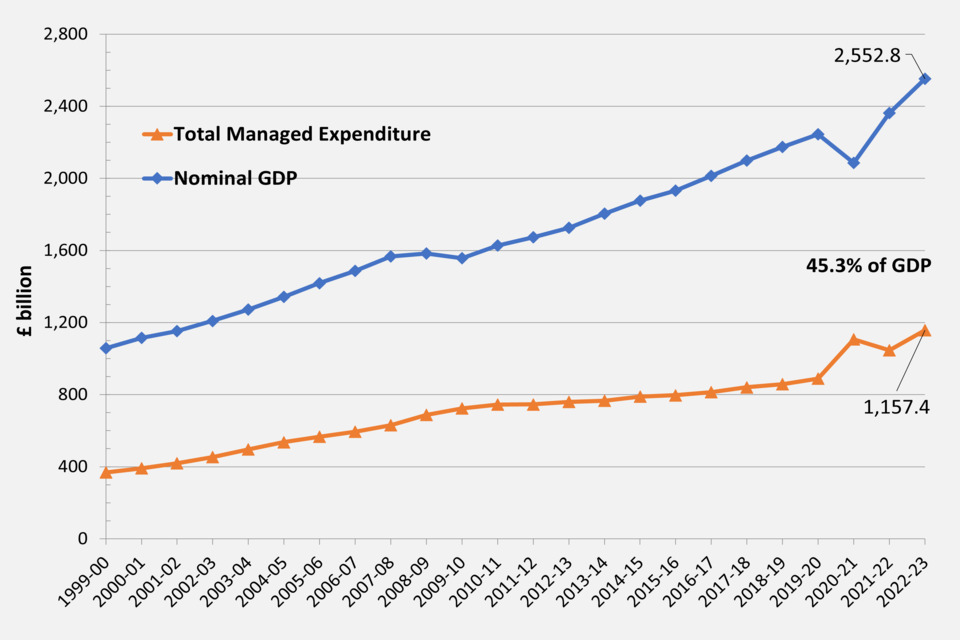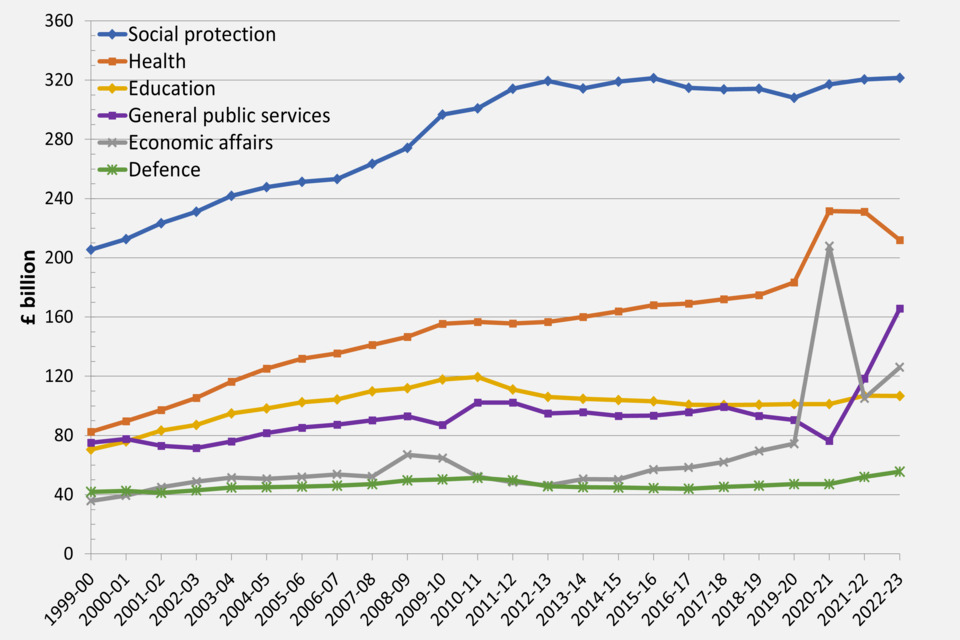Public spending statistics: February 2024
Published 28 February 2024
About this release
This release presents updated Public Spending data for the years 2018-19 to 2022-23. All data in this release are National Statistics and are on an outturn basis. TME figures are consistent with data published by the ONS in February 2024. All data and further background detail can be found in the accompanying tables published alongside this release. We welcome any feedback at pesa.document@hmtreasury.gov.uk
Total expenditure (£billions)
| Expenditure | 2021-22 | 2022-23 |
|---|---|---|
| Total DEL expenditure | 542.6 | 545.5 |
| Resource departmental AME | 618.1 | 363.7 |
Budgets are divided into Departmental Expenditure Limits (DEL), which are firm plans for three or four years, and Annually Managed Expenditure (AME), covering spending which is demand-led, less predictable and more difficult to control. In the accompanying excel tables, table 1 shows the aggregate position for all departments and all types of spending, with some of the main types of spending shown separately. Table 8 shows in detail how the budgeting data is used to construct the Total Managed Expenditure (TME) figures published by the Office for National Statistics. These are based on National Accounts concepts and are used in the aggregates which underlie the government’s fiscal policy.
| Expenditure | 2021-22 | 2022-23 |
|---|---|---|
| Total Managed Expenditure (TME) | 1,046.3 | 1,157.4 |
| Total expenditure on services (TES) | 954.1 | 1,074.9 |
- TME was £1,157.4 billion in 2022-23, an increase of 10.6 per cent on the previous year.
- TES was £1,074.9 billion in 2022-23, an increase of 12.7 per cent on the previous year.
Total Departmental Expenditure Limits, 2022-23 (£�����������DzԲ�)
For the full table, including years from 2018-19 onward, please refer to Table 7 in the accompanying budget tables excel.
| Departmental Group | Total DEL |
|---|---|
| Health and Social Care | 181,693 |
| Education | 81,793 |
| Home Office | 17,911 |
| Justice | 10,677 |
| Law Officers’ Departments | 771 |
| Defence | 52,797 |
| Single Intelligence Account | 3,796 |
| Foreign, Commonwealth and Development Office | 9,308 |
| DLUHC – Local Government | 11,772 |
| DLUHC – Housing and Communities | 10,655 |
| Culture, Media and Sport | 2,269 |
| Science, Innovation and Technology | 10,620 |
| Transport | 28,912 |
| Energy Security and Net Zero | 20,328 |
| Environment, Food and Rural Affairs | 5,976 |
| Business and Trade | 1,470 |
| Work and Pensions | 8,581 |
| HM Revenue and Customs | 6,407 |
| HM Treasury | 300 |
| Cabinet Office | 1,130 |
| Scotland | 42,028 |
| Wales | 18,071 |
| Northern Ireland | 15,631 |
| Small and Independent Bodies | 2,590 |
Budgeting Statistics (Tables 1 to 9)
- Total DEL expenditure (Resource DEL excluding depreciation plus Capital DEL) was £545.5 billion in 2022-23, an increase of £2.9 billion or 0.5 per cent on the previous year in nominal terms. The largest decrease in DEL spending in nominal terms in 2022-23 was for DLUHC – Local Government, which was down by £9.5 billion to £11.8 billion. This decrease is largely a result of expenditure related to Covid-19 measures falling in 2022-23. The largest increase in DEL spending in nominal terms in 2022-23 was for Energy Security and Net Zero, which increased by £7.2 billion to £20.3 billion. This increase is largely a result of expenditure related to the energy bills support scheme.
- Total departmental expenditure (Total DEL plus resource and capital departmental AME) was £943.6 billion in 2022-23, a decrease of £235.1 billion or 19.9 per cent on the previous year.
- Resource departmental AME was £363.7 billion in 2022-23, a decrease from £618.1 billion in 2021-22. The largest decrease in resource departmental AME spending in nominal terms in 2022-23 was for Energy Security and Net Zero, which was down by £196.4 billion to -£81.6 billion. This mainly reflected higher provisions for the Nuclear Decommissioning Authority (NDA) in 2021-22.
In the accompanying excel tables, tables 1 to 9 show central government departmental spending on a budgetary basis. These are the aggregates used by the government to plan and control expenditure. They cover departments’ own spending as well as support to local government and public corporations. They are consistent with “Estimates” voted by Parliament and broadly consistent with departmental Resource Accounts, which are based on commercial International Financial Reporting Standards (IFRS) adapted for the public sector.
Real terms public expenditure (£billions)
| Functions | 2021-22 | 2022-23 |
|---|---|---|
| General public services | 118.5 | 165.8 |
| Defence | 52.0 | 55.5 |
| Public order and safety | 42.5 | 44.2 |
| Economic affairs | 105.1 | 126.0 |
| Environment protection | 14.7 | 13.7 |
| Housing and community amenities | 16.3 | 17.3 |
| Health | 231.0 | 212.0 |
| Recreation, culture and religion | 13.8 | 14.4 |
| Education | 106.9 | 106.6 |
| Social protection | 320.4 | 321.5 |
In the accompanying excel tables, tables 10 to 11 present spending under the “expenditure on services” framework. This is based on National Accounts definitions and covers the whole of the public sector. It therefore has wider coverage than the budgeting framework and is also more stable over time.
Trends in functional expenditure (Tables 10, 10a and 10b)
Compared with the previous year:
- in real terms, spending in seven of the ten functions (excluding EU transactions) for 2022-23 increased whilst spending in three functions fell, compared to 2021-22.
- the largest real terms percentage increase was in general public services (39.9 per cent), mainly as a result of an increase in public sector debt interest.
- spending on health shows a nominal and real terms decrease in 2022-23 (2.0 per cent in nominal terms and 8.2 per cent in real terms). This is due to higher levels of expenditure in health for 2021-22, which was largely related to covid-19 measures.
In the accompanying excel tables, tables 10, 10a and 10b show public sector expenditure on services broken down by function over a longer number of years, allowing long-term trends to be identified. Table 11 presents data broken down by economic categories such as pay or grants.
National Statistics are accredited official statistics[footnote 1]. These accredited official statistics were independently reviewed by the Office for Statistics Regulation in . They comply with the standards of trustworthiness, quality and value in the Code of Practice for Statistics and should be labelled ‘accredited official statistics’.
Our statistical practice is regulated by the Office for Statistics Regulation (OSR). OSR sets the standards of trustworthiness, quality and value in the that all producers of official statistics should adhere to. For further information, please see the on the OSR website.
You are welcome to contact us directly with any comments about how we meet these standards. Alternatively, you can contact OSR by emailing regulation@statistics.gov.uk or via the OSR website.
Spending frameworks used in HM Treasury spending publications
| Budgeting | Expenditure on services (TES) |
|---|---|
| This framework provides information on central government departmental budgets, which are the aggregates used by the government to plan and control expenditure. It covers departmental own spending as well as support to local government and public corporations. | This framework is used in HM Treasury publications for statistical analysis. It is based on National Accounts definitions and covers spending by the whole of the public sector. It therefore has wider coverage than the budgeting framework and is also more stable over time. |
Trends in public spending
Chart 1: Trends in public spending since 1999-00

- TME as a percentage of GDP, which shows the size of the public sector relative to the size of the whole economy, was 45.3 per cent in 2022-23, which was an increase of 1.0 percentage points when compared to 2021-22. Figures for 2020-21 show the highest percentage (53.1 per cent) in the period covered by these tables (from 1999-00), reflecting not only increased spending, but also lower GDP as the economy entered recession during the Covid-19 pandemic.
Chart 2: Real terms trends in Public Spending

From 2011-12 onwards the ‘grant-equivalent element of student loans’ is no longer part of the TES framework and has therefore been removed from the Education function. Therefore, figures are not directly comparable between 2010-11 and 2011-12. A full explanation of this decision can be found in PESA 2016 Annex E.
Revisions in this release (since the July 2023 publication)
| Expenditure | Amount (£�����������DzԲ�) | Comments |
|---|---|---|
| Total DEL expenditure | -£333�� | Resource and Capital DEL (excluding depreciation) has been revised down in 2022-23. The decrease was largely driven by final outturn adjustments to expenditure made by Welsh Government. |
| Resource departmental AME | -£2,071�� | Driven mainly by downward revisions by DHSC in relation to the NHS Pension Scheme. |
Changes to Total Managed Expenditure (TME) and public sector debt interest in all years are due to updated ONS data. More information about these changes is available in the monthly .
Additional information about the PSS release
Upcoming revisions and changes in forthcoming releases
The next HM Treasury PSS National Statistics release will be published in May 2024. There are no expected changes to the spending frameworks for the next release.
PSS publication schedule for the coming year
| Date | Release |
|---|---|
| May 2024 | Contains updates to the PSS series. May is the first publication in which full outturn data for the previous financial year is published, incorporating final data for all local authorities and devolved administrations. |
| July 2024 | The July PSS release contains the first publication of departmental spending outturn for the 2023-24 financial year. Local authority data and much of the data from the devolved administrations are still provisional at this stage of the year. This is the main annual release. |
| Nov 2024 | As well as the PSS release, the Country and Regional Analysis (CRA) is also published in November each year. |
GDP deflators and money GDP
Real terms figures are the nominal figures adjusted to 2022-23 price levels using GDP deflators from the Office for National Statistics (released 22 December 2023).
| Financial year | GDP deflator at market prices (2022-23 = 100) | % per cent change on previous year | ����ֱ�� GDP (£�����������DzԲ�) |
|---|---|---|---|
| 2018-19 | 87.462 | 2.11 | 2,173,677 |
| 2019-20 | 89.527 | 2.36 | 2,244,509 |
| 2020-21 | 94.403 | 5.45 | 2,085,084 |
| 2021-22 | 93.629 | -0.82 | 2,361,920 |
| 2022-23 | 100.000 | 6.80 | 2,552,763 |
GDP Deflator: Financial years 2018-19 to 2022-23 taken from .
-
Accredited official statistics are called National Statistics in the Statistics and Registration Service Act 2007 ↩
